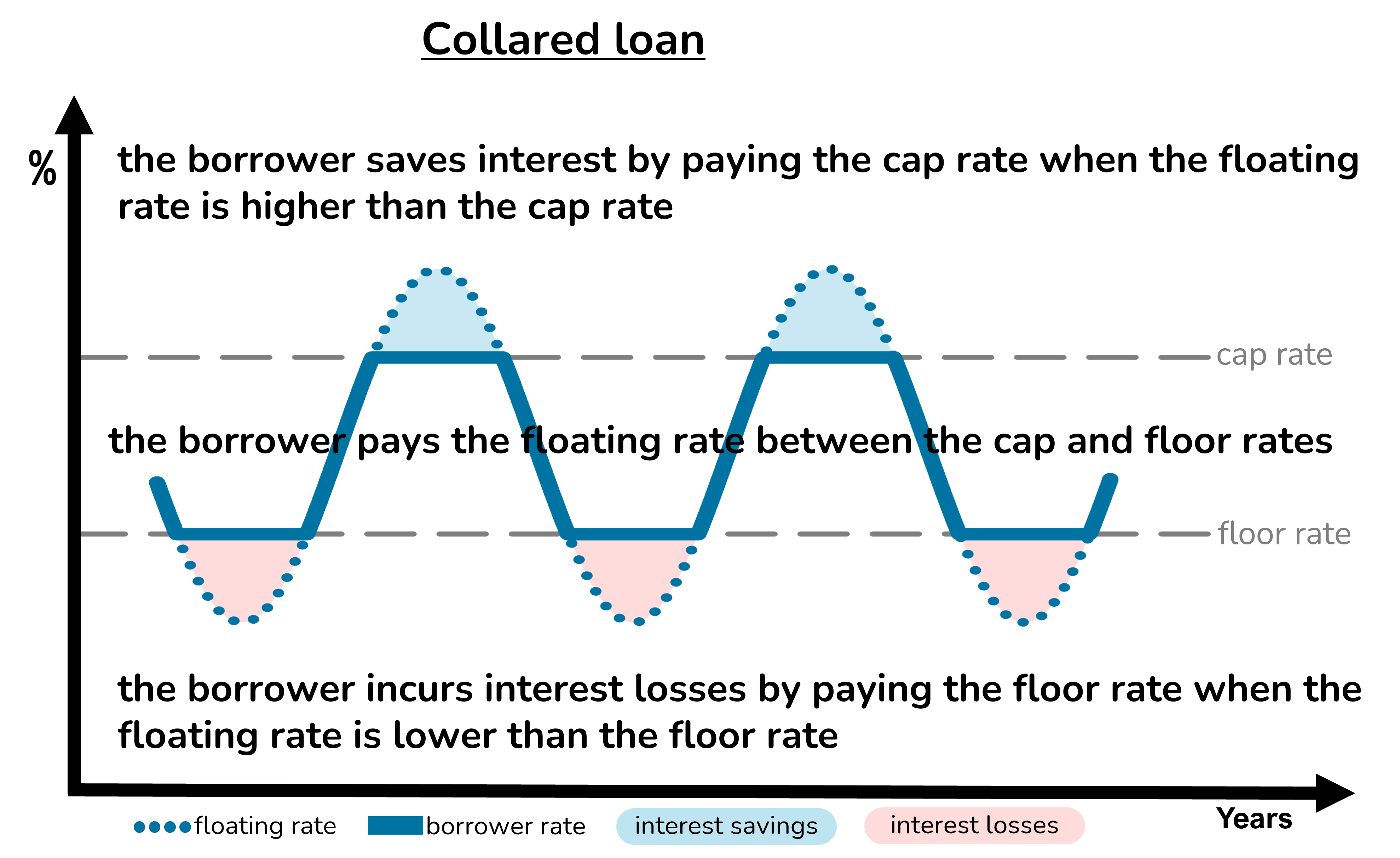What is a collared loan?
Cap with adverse floor


A collared loan is a floating rate loan with an embedded interest rate collar.
Collared loans protect borrowers against the possibility of interest rates rising above a chosen maximum, the collar cap rate.
The borrower pays for this protection by protecting the lender against the possibility of interest rates falling below a chosen minimum, the collar floor rate.
The borrower effectively sells a floor to pay for a cap.
When the floating rate is between the cap and floor rates of the collar, the borrower pays the floating rate.
When the floating rate is higher than the collar cap rate, the borrower pays less than the floating rate, making an interest saving due to the cap. The further the floating rate exceeds the collar rate, the greater the interest saving made by the borrower.
When the floating rate is lower than the collar floor rate, the borrower pays more than the floating rate, incurring an interest loss due to the adverse floor. The further the floating rate falls below the collar floor rate, the greater the interest loss incurred by the borrower.
The cap protects the borrower if interest rates rise. But the adverse floor exposes the borrower to risks if interest rates fall.
The risk of a collared loan is that, if interest rates fall, the borrower may become trapped in an expensive arrangement which may be difficult to exit without incurring potentially substantial break costs.
The adverse floor element may also impact the borrower’s loan-to-value position.
How is the collared loan premium paid?
Upfront or in instalments


A collared loan includes a cap in favour of the borrower offset by a floor in favour of the lender. The premium payable by the borrower for the cap protection is offset by the premium payable by the lender for the floor element.
Collared loans are often structured such that the initial premium payments cancel one another out. In these cases, there is no collared loan premium to be paid.
If there is a net premium payable for the collared loan, this may be paid upfront by the borrower.
Alternatively, the net premium may be factored into the collared loan pricing in the form of a higher floating rate than would otherwise have applied.
How are collared loans priced?
Factors influencing the loan terms


There are three key elements to the pricing of a collared loan: the premium payable by the borrower for the cap, the premium payable by the lender for the floor and the pricing of the underlying floating rate loan.
Cap premium: the value of the cap premium depends on the level of collar cap rate. The further the cap rate is above the swap rate, the cheaper the cap.
Floor premium: the value of the floor premium depends on the level of collar floor rate. The further the floor rate is below the swap rate, the cheaper the floor.
Floating rate loan: the interest rate payable on a floating rate loan is calculated as the benchmark rate (Base Rate or SONIA) plus the credit spread reflecting the lender’s required return for its risk in lending money.
The collar cap rate and the collar floor rate are often structured such that the cap premium and floor premium cancel one another out.
Alternatively, any net premium payable either way may be settled upfront or incorporated into the pricing of floating rate loan, effectively by adjusting the credit spread.
The pricing of the cap and floor premiums will fluctuate over time based on changes in market expectations regarding the future path of interest rates and interest rate volatility.
What are the risks of collared loans?
Break costs and contingent liabilities


Collared loans expose borrowers to risks.
If interest rates fall, the borrower may become trapped in an expensive arrangement. The borrower may find it difficult to exit the collared loan without incurring break costs.
The break costs of collared loans can potentially be substantial as a percentage of the amount borrowed.
The adverse floor element of the collared loan may also impact the borrower’s loan-to-value position. The contingent liability created by the potential break cost of the collared loan effectively adds to the amount being borrowed.
In some circumstances the contingent liability can lead to breaches of loan-to-value covenants and place the borrower in default of their loan obligations.
How to manage the risks of a collared loan?
With a favourable floor


The risks of a collared loan can be managed with a favourable floor.
A favourable floor protects its owner against falling interest rates.
The floor owner receives extra income when the floating rate is lower than the floor rate. The further the floating rate falls below the floor rate, the greater the extra income from the floor.
The floor income offsets the losses incurred by borrowers with collared loans.
The favourable floor also tends to appreciate in value when floating rates fall. Increases to the value of the beneficial floor offset the increased contingent liability created by the adverse floor contained in the collared loan.